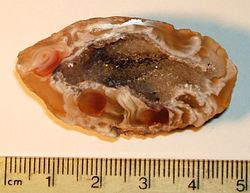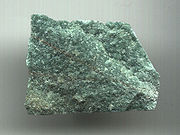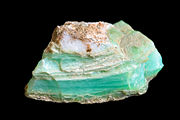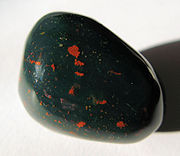- Chalcedony
-
Chalcedony
A cut and polished Chalcedony geodeGeneral Category Oxide mineral Chemical formula Silica (silicon dioxide, SiO2) Identification Molar mass 60 g / mol Color Various Crystal system Trigonal, Monoclinic Cleavage Absent Fracture Uneven, splintery, conchoidal Mohs scale hardness 6 - 7 Luster Waxy, vitreous, dull, greasy, silky Streak White Diaphaneity Translucent Specific gravity 2.59 - 2.61 References [1] Chalcedony (
 /kælˈsɛdəni/) is a cryptocrystalline form of silica, composed of very fine intergrowths of the minerals quartz and moganite.[2] These are both silica minerals, but they differ in that quartz has a trigonal crystal structure, while moganite is monoclinic. Chalcedony's standard chemical structure (based on the chemical structure of quartz) is SiO2 (Silicon Dioxide).
/kælˈsɛdəni/) is a cryptocrystalline form of silica, composed of very fine intergrowths of the minerals quartz and moganite.[2] These are both silica minerals, but they differ in that quartz has a trigonal crystal structure, while moganite is monoclinic. Chalcedony's standard chemical structure (based on the chemical structure of quartz) is SiO2 (Silicon Dioxide).Chalcedony has a waxy luster, and may be semitransparent or translucent. It can assume a wide range of colors, but those most commonly seen are white to gray, grayish-blue or a shade of brown ranging from pale to nearly black.
The name "chalcedony" comes from the Latin calcedonius, the word used to translate the Greek word khalkedon, found only once, in the Book of Revelation; according to the OED a connection with the town of Chalcedon in Asia Minor is "very doubtful".[3] There is no reason to assume that the precious stone referred to by this name in the Bible is the same as what is now understood by the name.[4]
Contents
Varieties
Chalcedony occurs in a wide range of varieties. Many semi-precious gemstones are in fact forms of chalcedony. The more notable varieties of chalcedony are as follows:
Agate
Agate is a variety of chalcedony with multi-colored curved or angular banding. Fire agate shows iridescent phenomena on a brown background; iris agate shows exceptional iridescence when light (especially pinpointed light) is shone through the stone. Landscape agate is chalcedony with a number of different mineral impurities making the stone resemble landscapes.[5]
Aventurine
Aventurine is a form of chalcedony, characterised by its translucency and the presence of platy mineral inclusions that give a shimmering or glistening effect termed aventurescence. Chrome-bearing fuchsite (a variety of muscovite mica) is the classic inclusion, and gives a silvery green or blue sheen. Oranges and browns are attributed to hematite or goethite.
Carnelian
Carnelian (also spelled cornelian) is a clear-to-translucent reddish-brown variety of chalcedony. Its hue may vary from a pale orange, to an intense almost-black coloration. Similar to carnelian is sard, which is brown rather than red.
Chrysoprase
Chrysoprase (also spelled chrysophrase) is a green variety of chalcedony, which has been colored by nickel oxide. (The darker varieties of chrysoprase are also referred to as prase. However, the term prase is also used to describe green quartz, and to a certain extent is a color-descriptor, rather than a rigorously defined mineral variety.)
Heliotrope
Heliotrope is a green variety of chalcedony, containing red inclusions of iron oxide. These inclusions resemble drops of blood, giving heliotrope its alternative name of bloodstone. A similar variety, in which the spots are yellow instead of red is known as plasma.
Moss agate
Moss agate contains green filament-like inclusions, giving it the superficial appearance of moss or blue cheese. There is also tree agate which is similar to moss agate except it is solid white with green filaments whereas moss agate usually has a transparent background, so the "moss" appears in 3D. It is not a true form of agate, as it lacks agate's defining feature of concentric banding.
Mtorolite
Mtorolite is a green variety of chalcedony, which has been colored by chromium. Also known as chrome chalcedony, It is principally found in Zimbabwe.
Onyx
Onyx is a variant of agate with black and white banding. Similarly, agate with brown, orange, red and white banding is known as sardonyx.
History
As early as the Bronze Age chalcedony was in use in the Mediterranean region; for example, on Minoan Crete at the Palace of Knossos, chalcedony seals have been recovered dating to circa 1800 BC.[6] People living along the Central Asian trade routes used various forms of chalcedony, including carnelian, to carve intaglios, ring bezels (the upper faceted portion of a gem projecting from the ring setting), and beads that show strong Greco-Roman influence.
Fine examples of first century objects made from chalcedony, possibly Kushan, were found in recent years at Tillya-tepe in north-western Afghanistan.[7] Hot wax would not stick to it so it was often used to make seal impressions. The term chalcedony is derived from the name of the ancient Greek town Chalkedon in Asia Minor, in modern English usually spelled Chalcedon, today the Kadıköy district of Istanbul.
At least three varieties of chalcedony were used in the Jewish High Priest's Breastplate. (Moses' brother Aaron wore the Breastplate, with inscribed gems representing the twelve tribes of Israel). The Breastplate included jasper, chrysoprase and sardonyx, and there is some debate as to whether other agates were also used.
In the 19th century Idar-Oberstein became the world's largest chalcedony processing center, in particular agates. Most of these agates were sourced in Latin America, in particular Brazil. Originally the agate carving industry around Idar and Oberstein was driven by local deposits that were mined in the 15th century.[8] Several factors contributed to the re-emergence of Idar-Oberstein as agate center of the world: ships brought agate nodules back as ballast, thus providing extremely cheap transport. Also, cheap labor and a superior knowledge of chemistry allowing them to dye the agates in any color with processes that were kept secret helped.
Each mill in Idar Oberstein had four or five grindstones. These were of red sandstone, obtained from Zweibrücken; and two men ordinarily worked together at the same stone.[8]
Geochemistry
Structure
Chalcedony was once thought to be a fibrous variety of cryptocrystalline quartz.[9] More recently however, it has been shown to also contain a monoclinic polymorph of quartz, known as moganite.[2] The fraction, by mass, of moganite within a typical chalcedony sample may vary from less than 5% to over 20%.[10] The existence of moganite was once regarded as dubious, but it is now officially recognised by the International Mineralogical Association.[11][12]
Solubility
Chalcedony is more soluble than quartz under low-temperature conditions, despite the two minerals being chemically identical. This is thought to be because chalcedony is extremely finely grained (cryptocrystalline), and so has a very high surface area to volume ratio.[citation needed] It has also been suggested that the higher solubility is due to the moganite component.[10]
Solubility of quartz and chalcedony in pure water
This table gives equilibrium concentrations of total dissolved silicon as calculated by PHREEQC using the llnl.dat database[citation needed].
Temperature Quartz Solubility (mg/L) Chalcedony Solubility (mg/L) 0.01°C 0.68 1.34 25.0°C 2.64 4.92 50.0°C 6.95 12.35 75.0°C 14.21 24.23 100.0°C 24.59 40.44 See also
References
- ^ Rudolf Duda and Lubos Rejl: Minerals of the World (Arch Cape Press, 1990)
- ^ a b Heaney, Peter J., 1994. Structure and Chemistry of the low-pressure silica polymorphs. In: Reviews in Mineralogy v. 29; Silica: Physical Behavior, geochemistry and materials applications. Ed. Heaney, P.J., Prewitt, C.T., Gibbs, G.V., 1-40
- ^ Harper, Douglas. "Chalcedony". Online Etymology Dictionary. http://www.etymonline.com/index.php?term=Chalcedony.
- ^ James Orr, ed (1915). "Chalkēdōn". The International Standard Bible Encyclopaedia. The Howard-Severance company. p. 2859. http://books.google.com/?id=CqPNAAAAMAAJ&pg=PA2859&dq=chalcedony+Chalkedon#v=onepage&q=chalcedony%20Chalkedon&f=false.
- ^ CIBJO (The World Jewellery Federation, international federation of all national trade organizations and gemological laboratories), Retailers' Reference Cuide: Diamonds, Cemstones, Pearls and Precious Metals, May 2009, Bern, Switzerland CIBJO member laboratories
- ^ C. Michael Hogan, Knossos fieldnotes, Modern Antiquarian (2007)
- ^ Section 12 of the translation of Weilue - a 3rd century Chinese text by John Hill under "carnelian" and note 12.12 (17)A. Also see Afghanistan's exhibition:Intaglio with depiction of a griffin, Chalcedony, 4th century BC, Afghanistan
- ^ a b Streeter, Edwin, 1898. Precious Stones and Gems. Page 237
- ^ Chalcedony mineral information and data. http://www.mindat.org/min-960.html
- ^ a b Heaney, Peter J., and Jeffrey E. Post. "The Widespread Distribution of a Novel Silica Polymorph in Microcrystalline Quartz Varieties." Science ns 255 (1992): 441-443. JSTOR. Aug. 2007. Keyword: moganite
- ^ Origlieri, Marcus. "Moganite: a New Mineral -- Not!" Lithosphere (1994). Aug. 2007 <http://fgms.home.att.net/moganite.htm>.
- ^ Nickel, Ernest H., and Monte C. Nichols. "IMA/CNMNC List of Mineral Names." Materials Data. June 2007. Aug. 2007 <http://www.geo.vu.nl/users/ima-cnmmn/MINERALlist.pdf>
External links
Crystalline Cryptocrystalline Amorphous Miscellaneous Notable varieties ChalcedonyCategories:- Quartz varieties
- Chert
- Lithics
- Trigonal minerals
Wikimedia Foundation. 2010.











